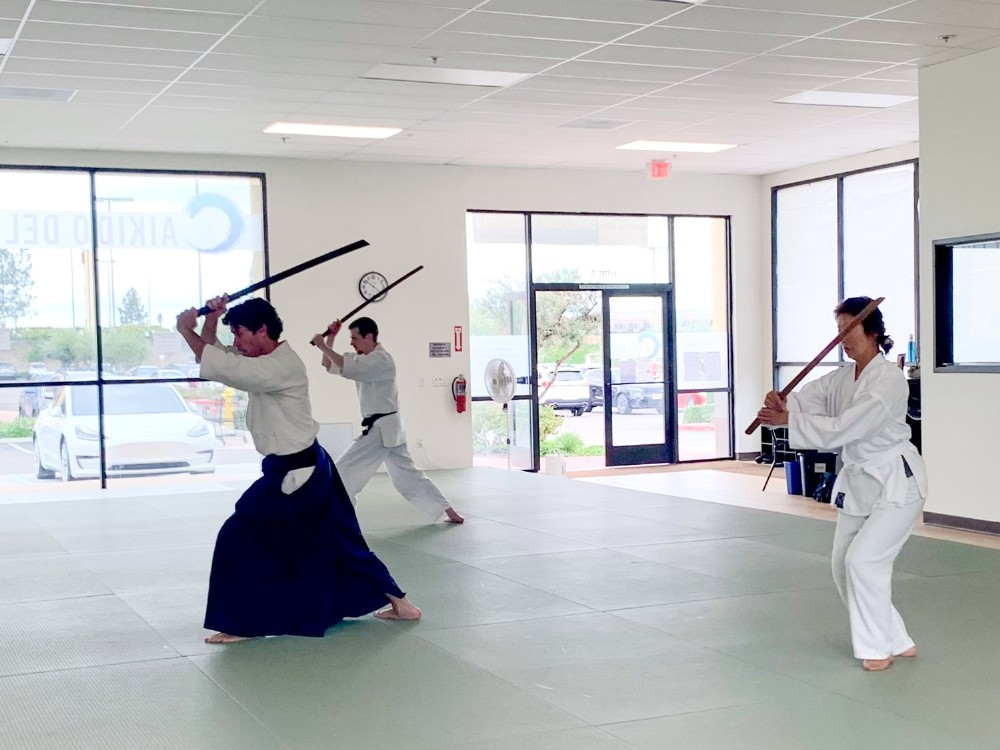Basic Keys of Aikido Bokken Practice

There are a number of articles and videos online that show or talk about bokken techniques in aikido, and there’s nothing wrong with that. People wanting to share their knowledge is never a bad thing, but when there’s an abundance of information, it can be difficult to know where to begin.
This is especially true if you’re just starting out as an aikido trainee because then you might be trying to learn something that’s too advanced without realising it. Or you might be learning something from a different school of aikido. That’s why in this article, we’re not really going to cover basic aikido bokken techniques. Instead, we’re going to look at some basic principles that will help you improve your practice.
Respect the Bokken
The bokken is a tool, yes, but it should still be treated with respect. To be more specific, you should be as careful with it as you would any bladed weapon because that’s what it represents. If you mishandle a bokken, your practice or training won’t be as effective. In general, you should only hold a bokken by the handle, just like you’d only use the handle of a sword.
Another way to look at it is that the bokken should be treated as an extension of your body, so you can move it more easily.
Hold the Bokken Lightly
Don’t confuse a light grip for a loose one. Hold the bokken firmly enough that it doesn’t slip, but not tight enough that it can’t be manipulated easily. Remember, too, that it should be your backhand that’s doing most of the work when swinging the bokken; the front hand that’s right by the guard is mainly supporting.
When you hold the bokken properly and lightly enough, you should be able to swing and move it as though it’s an extension of your arms rather than a separate object you’re holding. This will help to keep it steady and make it difficult for the target to slap away or deflect.
Keep Proper Form
Imagine that you’re facing someone and all you could see is the tip of a blade – not their face or arms. You know they’re holding a weapon, but you don’t know where they’re looking, and you don’t know where they’re going to move their arms – and in turn, where that weapon is going to move.
That’s the reason why when training with the bokken, you’re taught the proper form and how to fall into the ready position. You should be facing your opponent, feet planted but ready to move, and an invisible line extending from the tip of the bokken to between your opponent’s eyes.
This position tells your opponent that you’re ready to face them, but you’re not giving them any openings to attack you.
Remember that Relaxation Isn’t a Weakness
When you lift the bokken to attack, don’t forget to lift only as far as feels comfortable for you. This means you should feel no stretching at the front of your body, and your arms shouldn’t be straining. Then use the bokken’s weight to cut downward, instead of using your own strength. Otherwise, the movement will unbalance you and leave you vulnerable to attack – the very thing you were trying to avoid in the first place.
This is why relaxation is important in aikido bokken training. Not only do you conserve your energy, but you ensure that it’s easy for you to manoeuvre the bokken wherever and however you need to. Not only that, but your movements will be stable and fluid, leaving no opening for attack.
As you can see, these are all fairly simple changes or subtle changes but they will have a big effect on your bokken practice. Now, if you want to take your aikido training a step further, or you want to give formal training sessions a try, check out this page for more information.








